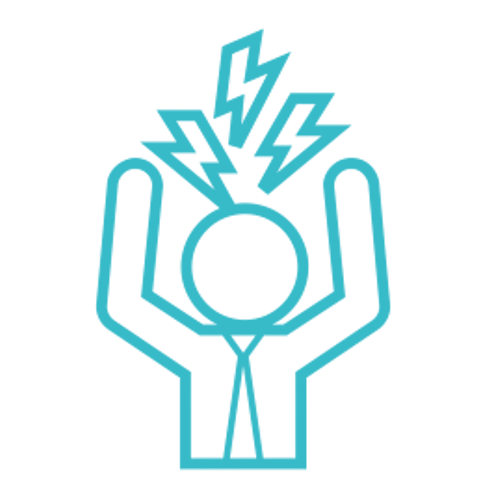Trauma blocking, often referred to as memory suppression or dissociative amnesia, is a psychological phenomenon where individuals experience difficulty recalling specific details or events related to a traumatic experience. This blog aims to delve into the intricacies of trauma blocking, its impact on memory recall, and strategies to cope with this challenging aspect of trauma.
Understanding Trauma Blocking
Trauma blocking is a fascinating psychological phenomenon that sheds light on how the human brain responds to traumatic experiences. When individuals undergo intense emotional distress or face life-threatening situations, their brains often initiate a protective mechanism known as trauma blocking. Essentially, this mechanism acts as a shield, safeguarding the individual from the full impact of the traumatic event.
Imagine the brain as a complex control center, constantly processing vast amounts of information. During a traumatic event, however, the brain shifts its focus from processing and storing memories to prioritizing immediate survival. This shift in focus is crucial for ensuring the individual’s physical safety in the face of danger.
As a result, memory storage becomes fragmented or disrupted. Instead of encoding the traumatic experience in a coherent narrative, the brain may store bits and pieces of information in an erratic and disjointed manner. These fragmented memories can create gaps or blanks in the individual’s recollection of the traumatic event, making it challenging to recall specific details or sequences of events.
The primary goal of trauma blocking is to shield the individual from overwhelming emotional distress associated with the traumatic experience. By inhibiting the full encoding of the traumatic memory, the brain aims to prevent the individual from being retraumatized every time they recall the event. In essence, trauma blocking serves as a protective mechanism, allowing the individual to cope with the aftermath of the trauma without being overwhelmed by its intensity.
However, while trauma blocking may offer temporary relief from emotional distress, it can also pose challenges for individuals trying to process and make sense of their traumatic experiences. The fragmented nature of memories can lead to confusion, frustration, and a sense of disconnection from one’s own experiences.
Moreover, trauma blocking can complicate the healing process, as individuals may struggle to confront and integrate their memories into a coherent narrative. Without proper support and guidance, these fragmented memories may linger unresolved, contributing to ongoing psychological distress and symptoms of post-traumatic stress disorder (PTSD).
Signs of Trauma Blocking
Recognizing the signs of trauma blocking can be crucial in understanding and addressing the impact of traumatic experiences on individuals. Here are some common indicators that someone may be experiencing trauma blocking:
Memory Gaps:
Individuals may have difficulty recalling specific details or sequences of events related to the traumatic experience, which can be attributed to memory loss and trauma. They may describe their memories as fragmented or disjointed, with significant gaps in their recollection.
Avoidance Behaviors:
People who are experiencing trauma blocking may actively avoid situations, conversations, or triggers that remind them of the traumatic event. This avoidance can be a coping mechanism to prevent the reactivation of distressing memories.
Emotional Numbing:
Trauma blocking can lead to a sense of emotional numbness or detachment from one’s feelings. Individuals may appear disconnected or apathetic towards their own experiences, as a way of coping with the overwhelming emotions associated with the trauma.
Flashbacks or Intrusive Memories:
Despite the presence of trauma blocking, individuals may still experience intrusive memories or flashbacks of the traumatic event. These memories may be triggered by certain cues or reminders in the environment, leading to intense emotional distress.
Difficulty Expressing Emotions:
Individuals experiencing trauma blocking may have difficulty expressing their emotions or describing their internal experiences. They may struggle to articulate their feelings or may seem guarded or withdrawn in their interactions with others.
Changes in Behavior or Personality:
Trauma blocking can manifest in changes in behavior or personality, such as increased irritability, mood swings, or social withdrawal. These changes may be a reflection of the internal turmoil and distress caused by unresolved traumatic memories.
Physical Symptoms:
Trauma blocking can also manifest in physical symptoms, such as headaches, gastrointestinal issues, or muscle tension. These symptoms may be a manifestation of the body’s physiological response to stress and emotional distress.
Sleep Disturbances:
Individuals experiencing memory loss post traumatic stress disorder (PTSD) may have difficulty sleeping or may experience nightmares and insomnia related to the traumatic event. Sleep disturbances are common symptoms of PTSD and other trauma-related disorders.
3 Major Impact of Trauma on Memory Recall
The impact of trauma blocking on memory recall can be profound, presenting individuals with significant challenges in processing and making sense of their traumatic experiences. Here’s a closer look at how trauma blocking manifests in various ways, affecting memory recall:
Fragmented Memories:
Traumatic events often disrupt the brain’s ability to encode memories in a coherent and organized manner. Instead of forming a linear narrative, memories of the traumatic event may be fragmented or disjointed. Individuals may recall isolated snippets of information, sensory impressions, or emotional fragments, rather than a cohesive sequence of events. This fragmentation can make it difficult to piece together the chronology of the traumatic experience and may result in gaps or inconsistencies in memory recall.
Memory Gaps:
One of the hallmark features of trauma blocking is the presence of significant gaps in memory. Certain aspects of the traumatic experience may be entirely inaccessible to conscious recall, leaving individuals with blank spaces or periods of amnesia. These memory gaps can be disconcerting and distressing, as individuals struggle to reconcile the discontinuities in their recollection of the event. Memory gaps may vary in duration and severity, with some individuals experiencing partial or selective amnesia for specific aspects of the traumatic experience.
Emotional Triggers:
Trauma blocking can also be triggered by certain cues or reminders in the environment, evoking intense emotional responses or flashbacks of the traumatic event. These emotional triggers may include sensory stimuli such as sights, sounds, smells, or tactile sensations associated with the traumatic experience. When exposed to these triggers, individuals may experience a flood of emotions, intrusive memories, or vivid flashbacks, further complicating memory recall. The emotional intensity of these triggers can be overwhelming, making it challenging for individuals to remain grounded and present in the moment.
Are high achievers particularly adept at trauma blocking?
High achievers, often driven by a relentless pursuit of success and excellence, possess certain characteristics and coping mechanisms that may make them particularly adept at trauma blocking. Here’s why high achievers may excel at this psychological defense mechanism:
Resilience and Adaptability:
High achievers are often resilient individuals who have developed effective coping strategies to navigate challenges and setbacks. Their ability to bounce back from adversity and adapt to new circumstances may enable them to cope with traumatic experiences by compartmentalizing or suppressing distressing memories.
Focus and Determination:
High achievers are known for their laser-like focus and determination to achieve their goals. When faced with traumatic events, they may channel their energy and concentration towards overcoming obstacles and maintaining forward momentum, rather than dwelling on past experiences that could impede their progress.
Goal Orientation:
High achievers are driven by clear goals and objectives, which provide them with a sense of purpose and direction. By focusing on their goals, they may be able to channel their attention away from traumatic memories and towards productive pursuits, effectively minimizing the impact of the trauma on their daily lives.
Emotional Control:
High achievers often exhibit a high degree of emotional control and self-discipline. They may possess the ability to regulate their emotions and maintain a composed exterior, even in the face of adversity. This emotional resilience may allow them to suppress or compartmentalize traumatic memories, preventing them from interfering with their professional or academic endeavors.
Perfectionism:
High achievers may hold themselves to exceptionally high standards and strive for perfection in all aspects of their lives. This perfectionistic mindset can drive them to suppress or deny experiences that do not align with their idealized self-image, including traumatic memories that may evoke feelings of vulnerability or weakness.
Avoidance of Vulnerability:
High achievers may be uncomfortable with vulnerability and prefer to maintain a façade of strength and competence. Acknowledging and processing traumatic experiences may require them to confront their own vulnerabilities, which they may perceive as a sign of weakness or failure. As a result, they may be more inclined to employ defense mechanisms such as trauma blocking to avoid facing these uncomfortable truths.
While these characteristics may enable high achievers to cope with traumatic experiences in the short term, it’s essential to recognize that trauma blocking is not a sustainable or healthy long-term coping strategy. Suppressing or denying traumatic memories can have detrimental effects on mental health and well-being, potentially leading to the development of chronic stress, anxiety, or other psychological disorders.
Can emotional trauma cause brain damage?
Emotional trauma, particularly severe and chronic stress, can indeed have profound effects on brain structure and function, potentially leading to brain damage from emotional trauma that resembles changes that resemble those seen in cases of physical brain damage. While emotional trauma itself does not cause direct physical injury to the brain in the same way as a traumatic brain injury (TBI), it can trigger a cascade of neurobiological changes that impact brain health and function over time.
Here’s how emotional trauma can potentially lead to brain damage or alterations in brain structure and function:
Neurochemical Imbalance:
Prolonged exposure to stress hormones such as cortisol and adrenaline, which are released in response to emotional trauma, can disrupt neurotransmitter balance and neuronal communication in the brain. Chronic stress can lead to dysregulation of the hypothalamic-pituitary-adrenal (HPA) axis, the body’s stress response system, contributing to neurochemical imbalances that may impair cognitive function and mood regulation.
Neuroplasticity:
The brain has a remarkable capacity for neuroplasticity, the ability to reorganize and adapt in response to experiences and environmental stimuli. However, chronic stress and trauma can dysregulate neuroplastic processes, leading to maladaptive changes in synaptic connectivity, neuronal morphology, and brain circuitry. These alterations may contribute to cognitive deficits, emotional dysregulation, and vulnerability to mental health disorders such as depression and anxiety.
Inflammation:
Emerging research suggests that chronic stress and trauma can trigger an inflammatory response in the brain, characterized by increased production of pro-inflammatory cytokines and activation of microglial cells, the brain’s resident immune cells. Neuroinflammation has been implicated in various neurological and psychiatric disorders and may contribute to neuronal damage, synaptic dysfunction, and cognitive impairment.
Structural Changes:
Studies using neuroimaging techniques such as magnetic resonance imaging (MRI) have revealed structural changes in the brains of individuals exposed to chronic stress and trauma. These changes may include alterations in gray matter volume, particularly in regions associated with emotion regulation (e.g., the amygdala and prefrontal cortex) and memory formation (e.g., the hippocampus). Reductions in hippocampal volume, in particular, have been consistently observed in individuals with PTSD and may contribute to memory deficits and impaired stress regulation.
While the term “brain damage” is typically associated with physical injury or neurodegenerative diseases, the term can also encompass alterations in brain structure and function resulting from environmental factors such as chronic stress and trauma. It’s important to recognize that the effects of emotional trauma on the brain are complex and multifaceted, and not all individuals exposed to trauma will experience the same degree of neurobiological changes. However, understanding the potential impact of emotional trauma on brain health underscores the importance of early intervention, support, and trauma-informed care to mitigate adverse outcomes and promote resilience and recovery.
How to Deal with Traumatic Memories
Dealing with traumatic memories can be challenging, but there are several strategies that individuals can employ to cope with and gradually process their traumatic experiences. Here are some effective approaches:
Seek Professional Help:
Consider seeking support from a qualified mental health professional, such as a therapist or counselor, who specializes in trauma treatment. Therapies like Cognitive Behavioral Therapy (CBT), Eye Movement Desensitization and Reprocessing (EMDR), and Trauma-Focused Cognitive Behavioral Therapy (TF-CBT) have been shown to be effective in helping individuals process and integrate traumatic memories in a safe and supportive environment.
Practice Grounding Techniques:
Grounding techniques can help individuals stay present and regulate their emotions when confronted with traumatic memories or triggers. Techniques such as mindfulness meditation, deep breathing exercises, progressive muscle relaxation, and sensory grounding exercises can help anchor individuals in the present moment and reduce the intensity of distressing emotions and memories.
Create a Safety Plan:
Develop a safety plan to help manage distressing emotions and cope with triggers when they arise. Identify supportive individuals you can reach out to for help, establish coping strategies and self-soothing techniques, and create a list of activities or distractions that help alleviate stress and anxiety.
Engage in Self-Care:
Prioritize self-care activities that promote physical and emotional well-being, such as regular exercise, adequate sleep, healthy nutrition, and relaxation techniques. Engaging in hobbies, creative pursuits, and activities that bring joy and fulfillment can also help individuals cope with the effects of traumatic memories and maintain a sense of balance and resilience.
Practice Compassion for Yourself:
Be gentle and compassionate with yourself as you navigate the process of dealing with traumatic memories. Acknowledge that healing takes time and that it’s okay to experience a range of emotions, including sadness, anger, and fear. Practice self-compassion by offering yourself kindness, understanding, and validation for your experiences and emotions.
Establish Boundaries:
Set boundaries to protect yourself from situations, people, or triggers that may exacerbate distressing memories or emotions. Communicate your boundaries assertively and prioritize your own well-being and safety.
Explore Creative Expression:
Expressing your feelings and experiences through creative outlets such as journaling, art therapy, music, or dance can be therapeutic and empowering. Creative expression can provide a nonverbal means of processing emotions, accessing subconscious feelings, and fostering self-awareness and healing.
Connect with Supportive Relationships:
Surround yourself with supportive friends, family members, or support groups who can provide validation, empathy, and understanding as you navigate the challenges of dealing with traumatic memories. Sharing your experiences with others who have gone through similar struggles can reduce feelings of isolation and offer a sense of community and belonging.
Don’t let emotional distress hinder your ability to recall memories – reach out today!
At Uncover Mental Health Counseling, we understand that trauma blocking can profoundly affect your life. Our compassionate team of therapists is here to provide you with the tools and support needed to navigate through these challenges. Follow these steps to gain a better understanding of trauma blocking and its impact on memory recall:
- Reach Out to Uncover Mental Health Counseling: Begin your journey by reaching out to us to schedule a complimentary 15 min consultation. We’re here to listen, understand, and offer guidance on your path to healing.
- Connect with our Experienced Trauma Therapists in NYC: Connect with one of our dedicated therapists who specialize in trauma blocking. Your initial session will provide you with a safe and confidential space to share your experiences and discuss your concerns.
- Start Understanding Trauma Blocking: Together with your trauma therapist, embark on a journey of understanding and growth. You’ll receive personalized support and guidance tailored to your unique needs. Our NYC trauma therapists will help you unravel the complexities of trauma blocking and develop strategies to enhance memory recall.






































